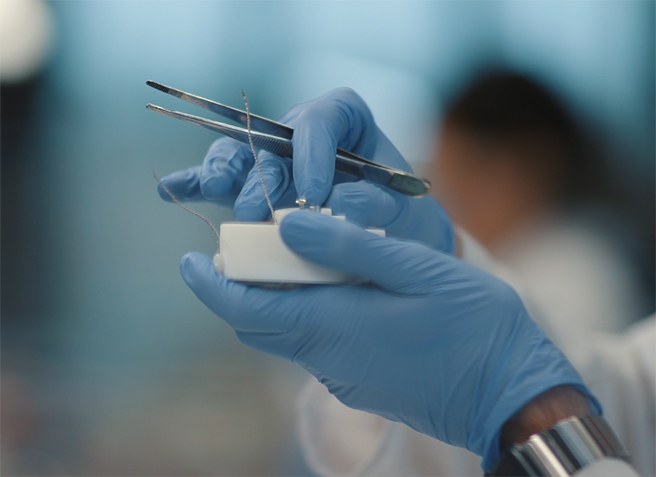Development of the first electrically rechargeable zinc-air battery in the HIPERZAB project

CICenergiGUNE. All rights reserved.
Zinc-air batteries: A Building Block for the Energy Transition
The increasing proportion of fluctuating renewable energy sources necessitates flexible and cost-effective storage solutions. Metal-air batteries, such as zinc-air batteries, could provide a solution to this challenge.
Metal-air batteries typically comprise a metallic foil as the negative electrode and a catalytically active layer as the positive electrode. The oxygen evolution or reduction occurs during charging or discharging. The components are immersed in an electrolyte solution, allowing charge carriers to move freely between the electrodes.
Zinc-air batteries are a type of metal-air battery that uses zinc as the negative electrode. They offer advantages over lithium-ion batteries which make them particularly appealing for stationary energy storage systems to store fluctuating renewable electricity. The use of non-critical raw materials and non-toxic materials, combined with high energy density and safety, makes it possible to produce inexpensive and compact energy storage systems. These systems could be suitable for longer storage times than a few hours, and could play a key role in the energy system of the future.
Zinc-air batteries that are primary, meaning non-rechargeable, are currently available in the market. They are commonly used in hearing aids or off-grid applications such as electric fences or traffic control. However, the commercialisation of a rechargeable version has been hindered by several obstacles: One major factor is the low electrical rechargeability due to the difficulty in reversing the processes in the battery, which limits the overall system's efficiency. As part of the HIPERZAB project, scientists are working to overcome these issues by optimising materials, components, and system design. Additionally, they aim to optimise the new batteries for medium-term electricity storage, lasting from several hours to days. This would make them a viable alternative in areas where no economically feasible options currently exist in the energy system.
HIPERZAB's material and process development
To achieve its goals, HIPERZAB is developing three innovative components: a negative electrode made of a porous zinc/3D biopolymer, a gel polymer electrolyte based on natural biopolymers, and a bi-functional positive electrode free of critical materials such as cobalt, nickel, or precious metals.
Success is difficult to achieve without a fundamental understanding of how materials and components interact with each other, the properties that determine their electrochemical behaviour and long-term stability. Therefore, the project requires the combination of novel investigation methods and multi-scale modelling to uncover ageing mechanisms and understand the interplay between materials, cell design, operating conditions, and their behaviour during operation. For instance, what impact does the air composition have on long-term stability? How can we achieve the longest possible storage periods? Which material combination offers the best balance between energy density, efficiency, and cycle stability? In addition to economic considerations, HIPERZAB's developments are accompanied by life cycle and circular economy approaches to ensure sustainable end-of-life options for the devices and minimize the technology's footprint. A small demonstrator cell will be created at the end of the 4-year period.
The DLR's role in the development of the zinc-air battery
"One of the key components of the zinc-air battery is the bi-functional oxygen electrode," says Dr. Dennis Kopljar, group leader of battery technology and project leader at the DLR Institute of Engineering Thermodynamics. "In order to develop a functioning battery, we need to understand exactly what happens inside the electrode during operation and what limits its performance and cycle stability. We can then use this knowledge to further develop them in a targeted manner."
DLR's task in the project is to develop, test, and extensively analyze these electrodes using various methods. The organization can draw on its many years of experience in manufacturing and testing electrodes for various applications. The ultimate goal is to adapt this complex type of electrode to this demanding task as effectively as possible. For instance, the catalyst must perform equally well in both oxygen development during charging and oxygen reduction during discharging, despite the fact that these two reactions have completely different requirements. The catalysts developed using AI-based methods will be supplied by the partners, while the manufacturing methodology and electrode design is based on the work of the DLR. Various methods will be used to characterise the newly developed materials and components, as well as the cell during and after operation. This will help to understand how the electrodes can be continuously improved. Cooperation between experimental work and modelling is essential to achieve a better understanding of processes that are difficult to access experimentally.
“With the proportion of renewable energy sources in our energy mix increasing, reliable storage technologies are needed to bridge periods of low solar and wind energy.” adds Dennis Kopljar. “These technologies must have a low carbon footprint and be economical. Success in this complex task requires interdisciplinary and international collaboration. Our team is excited to work towards this goal with great partners.”
The project
The European HIPERZAB project was launched in October 2023. The project involves the German Aerospace Centre, as well as six other companies and research centres, five of which are from the EU and one from Turkey.
These include the
- CENTRO DE INVESTIGACION COOPERATIVA DE ENERGIAS ALTERNATIVAS FUNDACION, a research institute inSpain
- CEGASA, a battery manufacturer in Spain
- SINTEF AS, a research institute in Norway
- POLITECNICO DI TORINO, a university in Italy
- FUNDACIO INSTITUT DE RECERCA DE L'ENERGIA DE CATALUNYA, a research institute in Spain
- ADVENST Enerji Depolama Sistemleri Sanayi ve Ticaret Anonim Sirket, a start-up in Turkey.
The project kick-off meeting was held at the headquarters of the Basque research centre CIC energiGUNE, which is leading the HIPERZAB project.
Funding by the European Innovation Council Pathfinder Programme
HIPERZAB was included in the European Union's Pathfinder Challenges Programme due to its highly disruptive approach to component development. The project was allocated a budget of 3.93 million euros over a period of 48 months, with DLR accounting for almost 840,000 euros of this.

